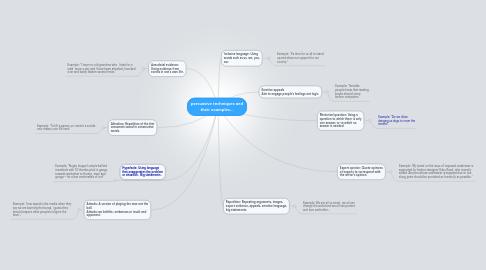persuasive techniques and their examples...
by fatima mohamed

1. Anecdotal evidence: Using evidence from events in one’s own life.
1.1. Example: ‘I have my old grandma who I take for a walk twice a day and I have been attacked, knocked over and badly shaken several times.’
2. Hyperbole: Using language that exaggerates the problem or situation. Big statements.
2.1. Example: ‘Rugby league’s ample bellied meatloafs with 10 thumbs plod in gangs towards eachother to thump, maul and gouge – for a few centimetres of turf.’
3. Rhetorical question: Using a question to which there is only one answer, or to which no answer is needed.
3.1. Example: ‘Do we allow dangerous dogs to roam the streets?’
4. Repetition: Repeating arguments, images, expert evidence, appeals, emotive language, big statements.
4.1. Example: We are all so smart, we all can change the world and we all can protect and love eachother...
5. Inclusive language: Using words such as us, we, you, our.
5.1. Example: ‘It’s time for us all to stand up and show our support for our country.’
6. Attacks: A version of playing the man not the ball. Attacks can belittle, embarrass or insult and opponent.
6.1. Example: 'how stupid is the media when they say we are banning the burqa, i guess they should respect other peoples religion the loser...'
7. Alitration: Repetition of the first consonant sound in consecutive words.
7.1. Example: 'To kill a person or commit a sucide only makes your life hard.'
8. Expert opinion: Quote opinions of experts to correspond with the writer’s opinion.
8.1. Example: ‘My stand on the issue of exposed underwear is supported by fashion designer Ruby Reed, who recently stated ‘Anyone whose underwear is exposed due to low slung jeans should be punished as forcefully as possible.’
9. Emotive appeals Aim to engage people’s feelings not logic.
9.1. Example: ‘Sensible people know that reading books should come before computers.’


